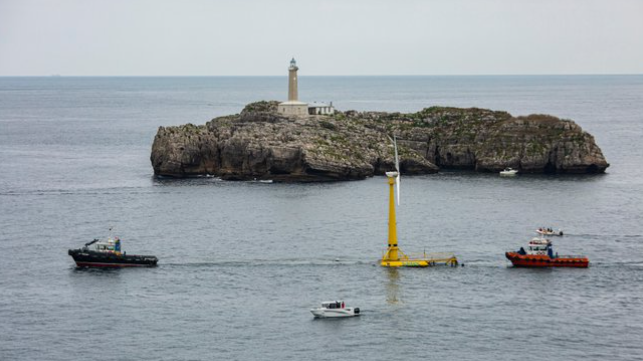Floating Wind Test Disrupted by Heavy Waves

A floating wind turbine testbed developed by Saitec Offshore Technologies has been damaged or capsized in heavy weather off the coast of Santander, Spain.
The 1:6 scale "BlueSATH" offshore wind prototype has a prestressed-concrete floating base with two hulls, and it is affixed to the seabed with a single-point mooring. The base is designed to swing about the mooring like an FPSO in order to optimize power generation in changing wind conditions. Like other concrete-base floating offshore wind designs, the SATH (Swinging Around Twin Hull) concept is intended to maximize local content and local labor involvement during construction.
The prototype was moored about 800 meters offshore in a sheltered location, and Saitec said that it had completed its planned test cycle for the year and was waiting for a tow back to shore for the winter season. Due to a series of storms in October, the tow was delayed, Saitec told local media.
When Hurricane Epsilon swept through the North Atlantic at the end of October, it pushed outsize waves towards the Bay of Biscay. According to Saitec, some of the peak wave heights recorded at the test site reached about 30 feet. Photos from the scene suggest that the test-scale BlueSATH platform capsized in these extreme condtions, with the normally-submerged platform base pointing upwards.
"There were waves of nine meters breaking just above the wind turbine and the slope was such that the structure leaned more than 35 degrees, which is the point of no return," Saitec technical director David Carrascosa told local outlet El Diario Montanes.
This is BlueSATH. Rocked by the waves and caressed by the sea breeze???????? #offshorewind #floatingwind #windenergy #floatingoffshorewind #renewableenergy #eólica (Picture by Nacho Fraile) pic.twitter.com/ZQAvVS9clD
— Saitec Offshore (@saitecoffshore) October 27, 2020
After results from the BlueSATH test are analyzed, a larger 2 MW prototype - the DemoSATH - will be built by Ferrovial Construction for Saitec and utility customer RWE Renewables. The 90-foot by 210-foot structure will be assembled in the Port of Bilbao, then towed out to a test site about two miles off the port in 85 meters of water. It will be moored using anchors connected by a hybrid system of chains and fiber line. The start of its operations are expected in early 2022.
